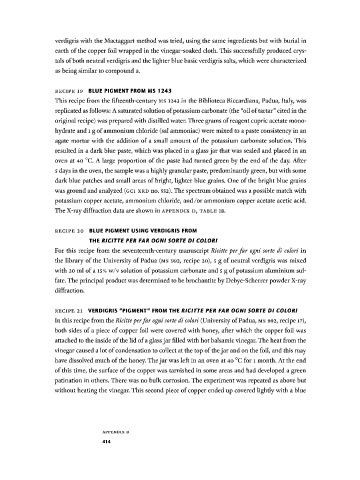Page 431 - Copper and Bronze in Art: Corrosion, Colorants, Getty Museum Conservation, By David Scott
P. 431
verdigris with the Mactaggart method was tried, using the same ingredients but with burial in
earth of the copper foil wrapped in the vinegar-soaked cloth. This successfully produced crys
tals of both neutral verdigris and the lighter blue basic verdigris salts, which were characterized
as being similar to compound B.
RECIPE 19 B L U E P I G M E N T F R O M M S 1 2 4 3
This recipe from the fifteenth-century M s 1243 in the Biblioteca Riccardiana, Padua, Italy, was
replicated as follows: A saturated solution of potassium carbonate (the "oil of tartar" cited in the
original recipe) was prepared with distilled water. Three grams of reagent cupric acetate mono-
hydrate and 1 g of ammonium chloride (sal ammoniac) were mixed to a paste consistency in an
agate mortar with the addition of a small amount of the potassium carbonate solution. This
resulted in a dark blue paste, which was placed in a glass jar that was sealed and placed in an
oven at 40 °C. A large proportion of the paste had turned green by the end of the day. After
5 days in the oven, the sample was a highly granular paste, predominantly green, but with some
dark blue patches and small areas of bright, lighter blue grains. One of the bright blue grains
was ground and analyzed (GCI XRD no. 552). The spectrum obtained was a possible match with
potassium copper acetate, ammonium chloride, and /or ammonium copper acetate acetic acid.
The X-ray diffraction data are shown in APPENDIX D, TABLE IS.
RECIPE 20 B L U E P I G M E N T U S I N G V E R D I G R I S F R O M
T H E RICITTE PER FAR OCNI SORTE DI COLORÍ
For this recipe from the seventeenth-century manuscript Ricitte per far ogni sorte di colon in
the library of the University of Padua (MS 992, recipe 20), 5 g of neutral verdigris was mixed
with 20 ml of a 15% w/v solution of potassium carbonate and 5 g of potassium aluminium sul
fate. The principal product was determined to be brochantite by Debye-Scherrer powder X-ray
diffraction.
"
RECIPE 21 V E R D I G R I S P I G M E N T " FROM T H E RICITTE PER FAR OCNI SORTE DI COLORÍ
In this recipe from the Ricitte per far ogni sorte di colorí (University of Padua, M s 992, recipe 17),
both sides of a piece of copper foil were covered with honey, after which the copper foil was
attached to the inside of the lid of a glass jar filled with hot balsamic vinegar. The heat from the
vinegar caused a lot of condensation to collect at the top of the jar and on the foil, and this may
have dissolved much of the honey. The jar was left in an oven at 40 °C for 1 month. At the end
of this time, the surface of the copper was tarnished in some areas and had developed a green
patination in others. There was no bulk corrosion. The experiment was repeated as above but
without heating the vinegar. This second piece of copper ended up covered lightly with a blue
A P P E N D I X Β
414

